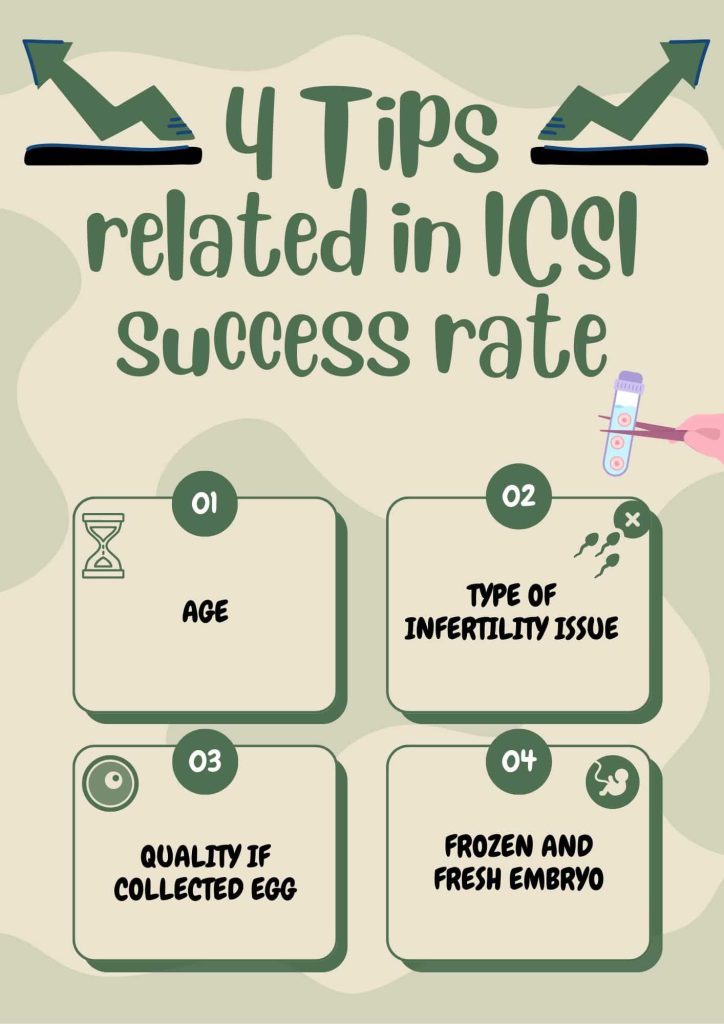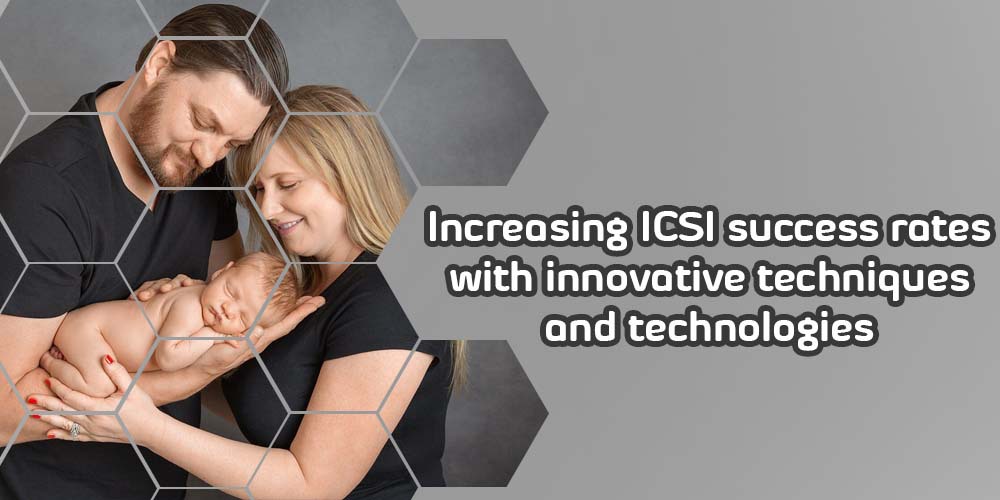In this blog post on TebMedTourism, we aim to generate comprehensive data on methods and techniques that could increase ICSI success rates. We present a range of highly effective procedures in assisted reproductive technology. Within advanced laboratories and clinics, these techniques can significantly enhance success rates. Specifically, Assisted Reproductive Technology (ART) methods have proven to be instrumental. Within the realm of assisted reproductive medicine, there exist various approaches to assist couples facing infertility challenges. Among them, one technique is remarkable in its effectiveness: Intracytoplasmic Sperm Injection (ICSI). In simpler terms, this method involves the direct injection of sperm into the egg. Beside the ICSI procedure, several other techniques have demonstrated the potential to improve success rates. For instance, sperm can be separated through centrifugation, isolating the highest quality sperm. Furthermore, Magnetic Activated Cell Sorting (MACS) enables the selection of healthy sperm while eliminating damaged ones. If you are currently experiencing infertility, it is important not to lose hope. Many advanced techniques, including ICSI, are available to increase your chances of achieving conception. If you wish to explore these innovative methods and technologies further, we invite you to read this comprehensive post, which covers the following topics in detail:
- Affecting Factors on ICSI success rate
- Does ICSI have higher success rates?
- The success rate of ICSI second time
- ICSI success rates under 30
- ICSI success rate calculator
- Male infertility ICSI success rates
ICSI fertility success rates
In recent years, many studies on ICSI success rate have contributed to the trend and popularity of ICSI, IVF sperm/egg donation, and surrogacy (the main types of assisted fertilization). In the last decade, ICSI fertility success rates have steadily increased, giving hope to couples looking to start a family. A study from 2019 revealed that almost 54 percent of couples using ICSI experienced a successful pregnancy, making it a popular choice for those seeking assisted fertility treatments. Alongside microinjection technique which outstands IVF from ICSI and has a vital role in increasing ICSI success rate compared to IVF, genetic tests like PGD/PGS, karyotyping, PGT-A, DFI, HA (Hyaluronic Acid) and the other techniques if the patients order could create a surprising result and successful pregnancy at the first ICSI cycle!
ICSI Hero | ICSI success rates for male infertility treatments
Set against the backdrop of couples struggling with infertility, particularly male infertility, the remarkable process of Intracytoplasmic Sperm Injection (ICSI) emerges as a beacon of hope in the journey towards starting a family. Extensive research has unveiled the undeniable success of ICSI, with reported success rates ranging from an impressive 40% to an astounding 90%. In a groundbreaking study conducted in 2014, the transformative power of ICSI was illuminated. Among couples grappling with male infertility, a staggering 40% achieved the cherished dream of conceiving after a single ICSI treatment. Such remarkable success rates have been consistently observed in numerous studies, offering resounding affirmation that ICSI holds the key to overcoming male infertility hurdles, such as low sperm counts. ICSI demonstrates its effectiveness and emerges as an accessible and cost-efficient solution for couples yearning to embrace the joy of parenthood. It serves as a potent tool to realize their long-held aspirations of creating a loving family. The success rates associated with ICSI leave no doubt regarding its capacity to rewrite the narrative of infertility, providing a newfound sense of possibility and optimism. To further empower couples on this transformative path, we delve into statistics and data, answering the pivotal question: "What are the success rates of ICSI?" Delving into these figures, it becomes apparent that ICSI boasts impressive pregnancy rates, ranging from a notable 30% to a remarkable 60% per cycle. It is important, however, to approach these success rates with an awareness that individual circumstances can influence outcomes, and no fertility treatment can guarantee absolute success. While male infertility often serves as the impetus for embracing ICSI, it is crucial to acknowledge that the success rate of this transformative procedure intertwines with several pivotal factors.
Affecting Factors on ICSI success rate
ICSI is one of the greatest advances in the treatment of infertility. This infertility treatment process has many influencing factors on the success rate, such as age, duration of infertility issues, type of infertility issues, the number of eggs collected during the last egg retrieval procedure, and whether frozen or fresh embryos were used. We explore each item separately in the following: 
Age
Age is an essential factor, as infertility risks become greater with advancing age, especially in women. So finding a quicker way to overcome age and fertility issues is necessary. Based on the World Health Organization (WHO), infertility is a situation that lasts for more than one year without conception. Ultimately, suppose you have tried for over a year and don't get the best result. In that case, it's time to make a new decision, and the ICSI procedure has a miracle technique (microinjection, for injecting sperm into an egg) that can help achieve success for infertile couples! ICSI is the quickest way to overcome age and infertility issues which, besides PGD/PGS tests and advanced technical approaches, could ease your mind from having a child with genetic problems!
Type of infertility issues
Another influencing factor on ICSI success rate is the type of infertility issues, such as sperm problems, irregular menstruation cycles, or ovarian problems. Understanding the exact infertility issues could give the specialist more details on solving them, leading to a greater success rate.
Eggs collected in your last egg retrieval procedure
The number of eggs collected in the previous egg retrieval procedure is also important. If the number of eggs retrieved is tiny, the chance of a successful outcome is slim. ICSI with egg donation or surrogacy will be proposed to patients in such cases. However, do not despair; there is always a way to have children! We have followed this path for a long time, and many patients have trusted TebMedTourism on this path to form happy families.
Frozen or fresh embryos
By understanding these factors affecting the ICSI success rate, maximizing the chance of success when utilizing ICSI as an infertility treatment is possible. The last one, the success of ICSI, also depends on whether frozen or fresh embryos were used. The advantage of using fresh embryos is that they usually have a greater success rate, as they contain higher levels of developmental potential. Moreover, whether you're using a frozen or fresh embryo can affect the success rate. The research results show ICSI with fresh eggs has more success rates than ICSI with frozen eggs. Choosing between fresh and frozen depends on various factors and, of course, your preferences! But the policy of TebMedTourism is using fresh eggs in the ICSI process for our dear patients! Although, we have a fabulous suggestion if you are on a tight budget! Going through ICSI treatment with the most affordable cost by TebMedTourism is only $3,500!
Innovative Techniques and Technologies in ICSI
Getting valuable insights into the reproductive system to help couples make their dream of having a family come true requires knowledge, experience, and hard work to overcome challenges. This required a lot of precision and care since every decision could affect the outcome of the patient's ART journey. The first priority is equipping labs and clinics with advanced technologies like high-powered microscopes to detect defects or abnormalities. Secondly, utilizing various tools, including a microfluidic system, that can analyze samples at the cellular level and after assessing the quality, ultimately, genetic analysis for the couple with a history of genetic issues is necessary.In this article, we have focused on the following techniques utilized to increase ICSI success rates, and each one has its efficiency in increasing the success rate of each step's ICSI.
Centrifuging sperms (sperm selection in ICSI)
Centrifuging sperm is a process that can make all the difference regarding successful IVF or ICSI treatments. In cases where the concentration of sperm in the ejaculate is low, or there is a risk of contamination from urine, this technique is practical. Thanks to advanced centrifuges, nowadays, doctors are able to spin semen samples at incredible speeds, effectively separating the best sperm from the rest. The result? High-quality, healthy sperm that are ready to fertilize an egg. But perhaps the most remarkable application of this technique is in HIV-positive couples. By carefully washing and selecting the sperm using centrifugation, doctors can drastically reduce the risk of HIV transmission during fertility treatments. This method is nothing short of a miracle for couples struggling with infertility's emotional and physical toll. And as more and more HIV-positive couples turn to assisted reproduction for their dreams of parenthood, this technique will continue to spread its wings and help families thrive.
Increasing ICSI success rate by MACS
Magnetic-activated cell sorting (MACS) can effectively eliminate sperm with high levels of DNA fragmentation. The results of this method which used on 724 cases of ART (assisted-reproduction-technique) treatments, were surprisingly promising. Significantly lower miscarriage rates in ICSI cycles and higher pregnancy rates in ICSI egg donation cycles have been observed. This method is performed in Iran by TebMedTourism in collaboration with Royan Research Institute researchers. ICSI success rate increased to more than 60% by TebMedTourism. In the first step, this method was performed on 100 infertile couples, and after confirming successfully, it was commonly used in the Infertility Treatment Center of Isfahan. In this case, the suitable sperms for fertilization are separated from the unsuitable sperms by the MACS method; according to this genetic point that when the sperm deteriorates or its gene is damaged, it shows markers on its surface through which scientists will be able to separate the good sperm from the bad. Cells are separated by molecular loading through magnets so that the protein marker for iron and its ability to be absorbed by a magnet can separate the bad cells by connecting.
DFI or DNA fragmentation index (DFI)
Testing the quality of semen via the DFI technique is one of the innovative technologies in which couples could find out if they can conceive naturally or if they would need the assistance of modern medical technology from ART treatments. Specialists will look at the general characteristics and semen parameters, as well as the DNA fragmentation index, or DFI. DFI was a measure of the integrity and damage of DNA in sperm, for which a DFI score below 30% was considered normal. A 30% or higher score indicated potential damage to the genetic material. When the DFI score is below 30%, and the man can let out a massive sigh of relief, but there are problems with fertility, doctors will ask for more technical tests; stay tuned to get more information on the other innovative techniques and technologies!
Embryoscope (technological part)
The Embryoscope is a marvel of technology that revolutionizes the field of embryology. This incredible microscope allows embryologists to monitor the developmental process of embryos with greater clarity and precision than ever before. Using a high-resolution camera and an incubator, the Embryoscope captures detailed images of embryos at various stages of development. In the past, embryologists would have to remove embryos from the incubator and inspect them manually under a microscope. This process was not only time-consuming but also disruptive to the delicate development process of the embryo. Thanks to the Embryoscope, the process of ICSI/IVF has become even more precise and accurate, giving couples struggling with infertility greater hope for a successful pregnancy. With its advanced technology and incredible capabilities, the Embryoscope is truly a game-changer in the field of embryology.
HA works as a miracle in successful implantation!
Hyaluronic Acid (HA) is a material that was discovered in 1950 and is responsible for connecting tissues in the body and supporting numerous functions! Hyaluronic acid secretes naturally during the mid-proliferative and late secretory phases. It produces a viscous solution that may support the embryo transfer process and avoid exclusion from the uterine cavity. This technique for increasing ICSI success rate is so accepted in many types of research that HA ICSI will be used in two steps. First, where the sperm is selected based on its ability to bind to hyaluronic acid before being injected directly into the egg. This technique may improve the chances of successful fertilization and embryo development. Second, at ET (Embryo Transfer) step, before transferring the embryo to the uterus. HA-ICSI before embryo transfer may improve the chances of successful pregnancy and live birth.
ICSI success rate calculator
The ICSI success rate calculator is a precious tool for couples struggling with infertility. To determine the rate of success for ICSI, we look at a variety of factors: woman's age, duration of infertility (in years), type of infertility, previous pregnancy status, type of treatment, year of first egg retrieval, and the number of eggs collected during last egg retrieval procedure. We also consider whether or not frozen or fresh embryos are being used. For instance, women who use fresh embryos tend to have higher success rates, as these embryos are generally healthier than those that have been frozen. These factors all interact to help us determine the probability of a successful pregnancy. Suppose a woman is young, with a short infertility duration and healthy embryos. In that case, she is likely to have a higher success rate with ICSI than someone with endometriosis and a longer duration of infertility. Overall, the ICSI success rate calculator is an excellent tool to give couples an idea of the success rates associated with ICSI, which consider the following items:
- woman's age
- duration of infertility (years)
- type of infertility (problems with the fallopian tubes, absent ovulation, endometriosis, male factor, or unexplained)
- previous pregnancy status (yes or no)
- treatment type (IVF or ICSI)
- year of first egg retrieval
- Eggs collected in your last egg retrieval procedure
- Frozen or fresh embryos
TebMedTourism's team of experts understands your needs, provides customized solutions, and offers valuable insights. With us, you will be able to get familiar with advanced technologies, know about their impact on ICSI success rates, learn the necessary tips and resources; and if needed, they can even assist you in choosing the best ART treatments and in getting an affordable plan. Knowing about all of these is like a labyrinth! How to get out of this labyrinth with success and happiness? It has only one way, trusting a professional and well-skilled company called TebMedTourism! Call us!




Comments & Questions